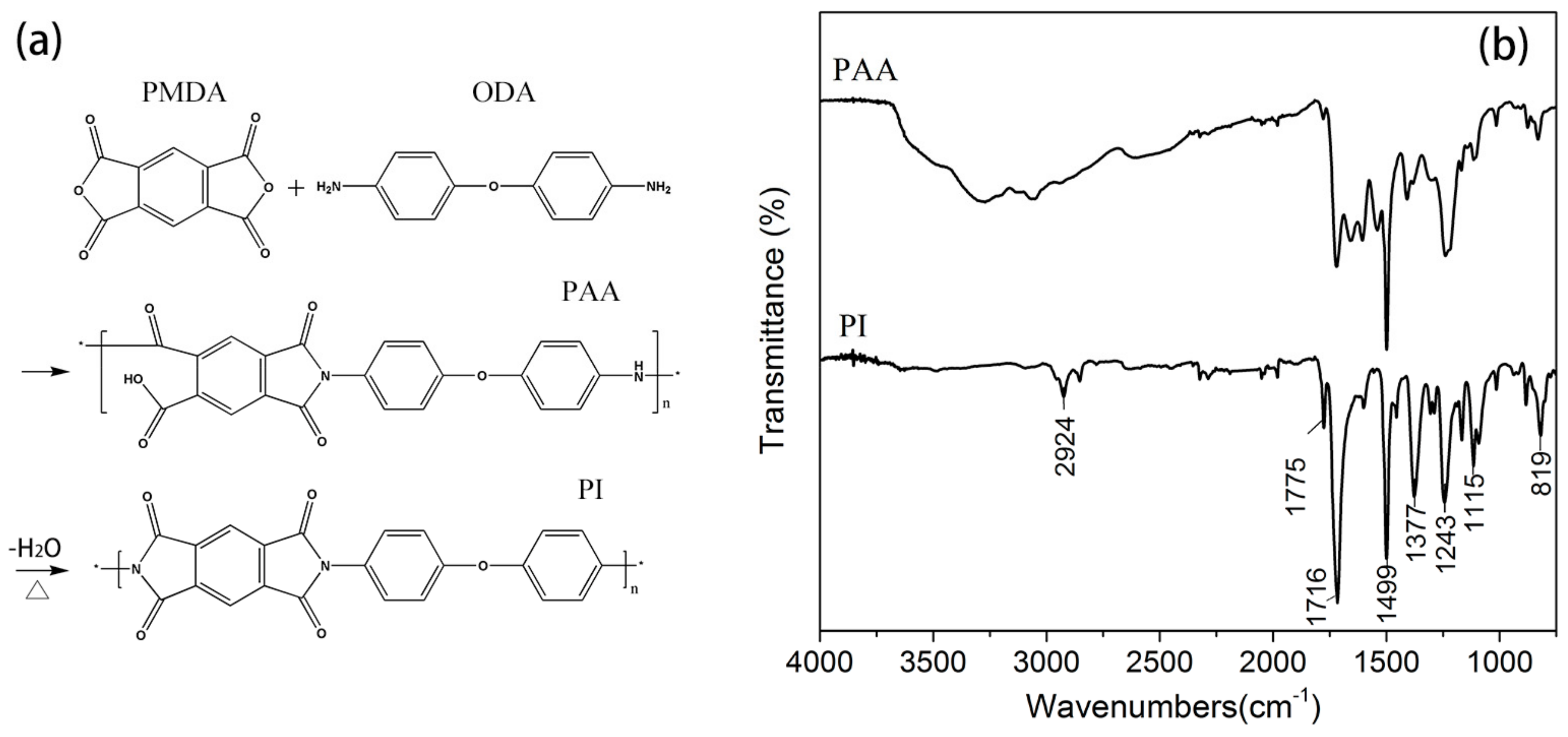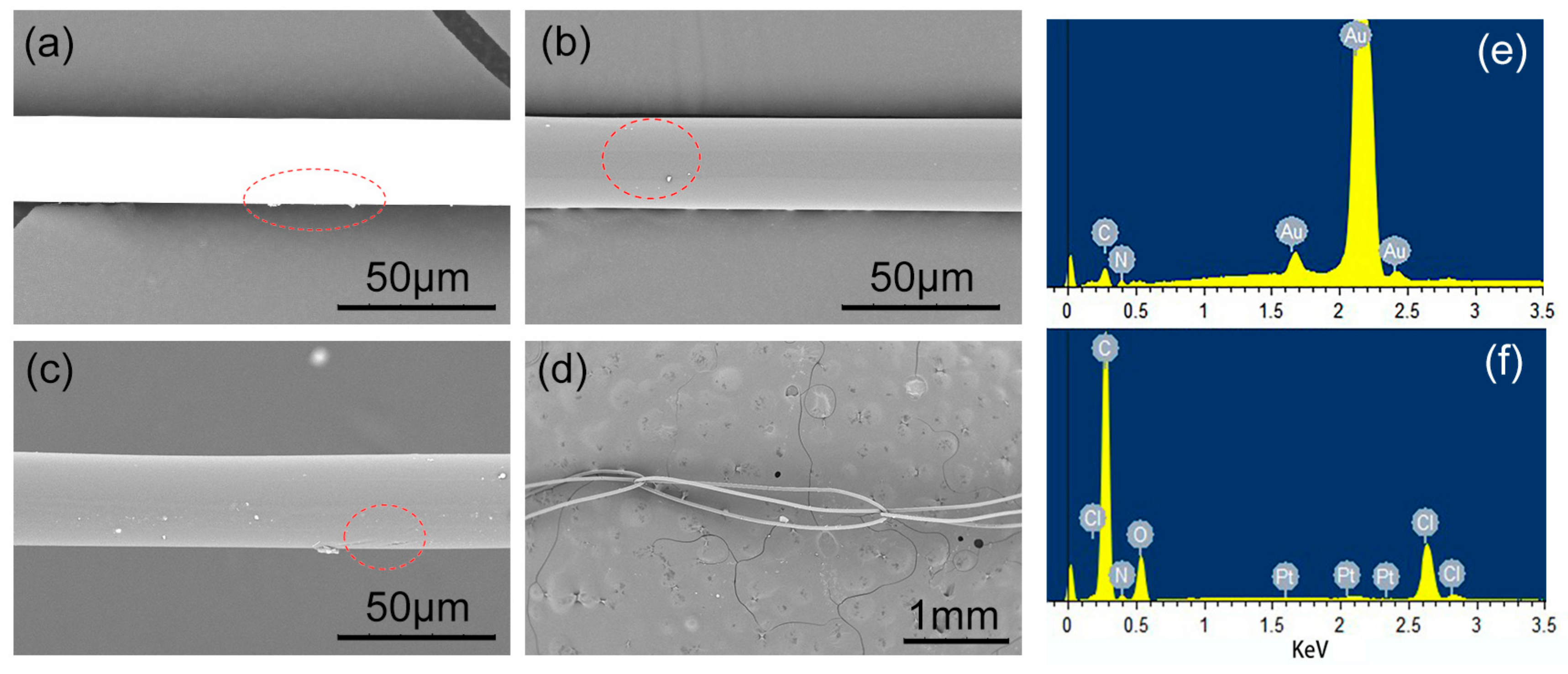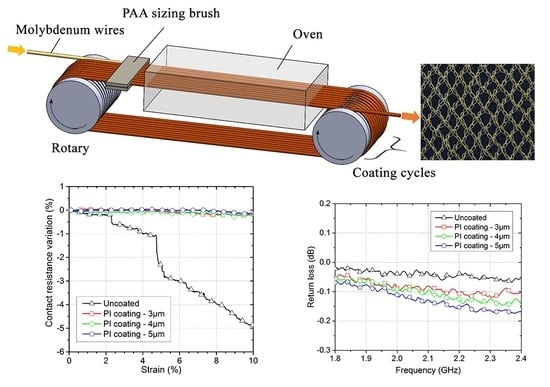Preparation and Evaluation of a Polyimide-Coated Ultrafine Gilt Molybdenum Wire and Its Knitted Mesh Used for Electromagnetic Reflectors
Abstract
:1. Introduction
2. Materials and Methods
2.1. Materials
2.2. Preparation of PAA Solution
2.3. Fabrication of PI-Coated Gilt Molybdenum Wire and Its Knitted Mesh
2.4. Fourier-Transform Infrared Spectroscopy (FTIR)
2.5. Morphology Study
2.6. Tensile Properties
2.7. Wire Mesh Contact Resistance
2.8. Microwave Reflection Properties
3. Results and Discussion
3.1. FTIR Analysis
3.2. Surface Morphology and Temperature Stability
3.3. Tensile and Wear Performance
3.4. Mesh Contact Resistance Stability
3.5. Electromagnetic Microwave Reflection Properties
4. Conclusions
Acknowledgments
Author Contributions
Conflicts of Interest
References
- Imbriale, W.A.; Gao, S.S.; Boccia, L. Space Antenna Handbook; John Wiley & Sons: New York, NY, USA, 2012; pp. 106–125. ISBN 9781119993193. [Google Scholar]
- Thakre, P.; Yang, V. Chemical Erosion of Refractory-Metal Nozzle Inserts in Solid-Propellant Rocket Motors. J. Propuls. Power 2009, 25, 40–50. [Google Scholar] [CrossRef]
- Li, T.; Jiang, J.; Shen, T.; Wang, Z. Analysis of Mechanical Properties of Wire Mesh for Mesh Reflectors by Fractal Mechanics. Int. J. Mech. Sci. 2015, 92, 90–97. [Google Scholar] [CrossRef]
- Zach, M.P.; Ng, K.H.; Penner, R.M. Molybdenum Nanowires by Electrodeposition. Science 2000, 290, 2120–2123. [Google Scholar] [CrossRef] [PubMed]
- Lui, P.L. Passive Intermodulation Interference in Communication Systems. Electron. Commun. Eng. J. 1990, 2, 109–118. [Google Scholar] [CrossRef]
- Bolli, P.; Selleri, S.; Pelosi, G. Passive Intermodulation on Large Reflector Antennas. IEEE Antennas Propag. Mag. 2002, 44, 13–20. [Google Scholar] [CrossRef]
- Shi-quan, Z.; De-biao, G. The Generation Mechanism and Analysis of Passive Intermodulation in Metallic Contacts. In Proceedings of the 2006 4th Asia-Pacific Conference on Environmental Electromagnetics, Dalian, China, 1–4 August 2006; pp. 546–549. [Google Scholar]
- Li, J.; Ma, X.; Li, T. Fast Contact Force Calculation Method for a Wire Mesh Based on Support Vector Machine. Int. J. Comput. Mater. Sci. Eng. 2017, 6, 1750009. [Google Scholar] [CrossRef]
- Liaw, D.-J.; Wang, K.-L.; Huang, Y.-C.; Lee, K.-R.; Lai, J.-Y.; Ha, C.-S. Advanced Polyimide Materials: Syntheses, Physical Properties and Applications. Prog. Polym. Sci. 2012, 37, 907–974. [Google Scholar] [CrossRef]
- Miki, M.; Horiuchi, H.; Yamada, Y. Synthesis and Gas Transport Properties of Hyperbranched Polyimide–Silica Hybrid/Composite Membranes. Polymers 2013, 5, 1362–1379. [Google Scholar] [CrossRef]
- Wang, Q.; Bai, Y.; Xie, J.; Jiang, Q.; Qiu, Y. Synthesis and Filtration Properties of Polyimide Nanofiber Membrane/Carbon Woven Fabric Sandwiched Hot Gas Filters for Removal of PM 2.5 Particles. Powder Technol. 2016, 292, 54–63. [Google Scholar] [CrossRef]
- Zhang, T.; Zhao, Y.; Wang, K. Polyimide Aerogels Cross-Linked with Aminated Ag Nanowires: Mechanically Strong and Tough. Polymers 2017, 9, 530. [Google Scholar] [CrossRef]
- Weiser, E.S.; Johnson, T.F.; St Clair, T.L.; Echigo, Y.; Kaneshiro, H.; Grimsley, B.W. Polyimide Foams for Aerospace Vehicles. High Perform. Polym. 2000, 12, 1–12. [Google Scholar] [CrossRef]
- Otte, K.; Makhova, L.; Braun, A.; Konovalov, I. Flexible Cu(In,Ga)Se2 Thin-Film Solar Cells for Space Application. Thin Solid Films 2006, 511–512, 613–622. [Google Scholar] [CrossRef]
- Khaleel, H.R.; Al-Rizzo, H.M.; Rucker, D.G.; Mohan, S. A Compact Polyimide-Based UWB Antenna for Flexible Electronics. IEEE Antennas Wirel. Propag. Lett. 2012, 11, 564–567. [Google Scholar] [CrossRef]
- Sarkisov, G.S.; Rosenthal, S.E.; Struve, K.W.; McDaniel, D.H. Corona-Free Electrical Explosion of Polyimide-Coated Tungsten Wire in Vacuum. Phys. Rev. Lett. 2005, 94, 035004. [Google Scholar] [CrossRef] [PubMed]
- Kim, M.C.; Kim, S.H.; Aravindan, V.; Kim, W.S.; Lee, S.Y.; Lee, Y.S. Ultrathin Polyimide Coating for a Spinel LiNi0.5Mn1.5O4 Cathode and Its Superior Lithium Storage Properties under Elevated Temperature Conditions. J. Electrochem. Soc. 2013, 160, A1003–A1008. [Google Scholar] [CrossRef]
- Naganuma, T.; Naito, K.; Yang, J.-M. High-Temperature Vapor Deposition Polymerization Polyimide Coating for Elimination of Surface Nano-Flaws in High-Strength Carbon Fiber. Carbon 2011, 49, 3881–3890. [Google Scholar] [CrossRef]
- Yuan, H.; Lu, C.; Zhang, S.; Wu, G. Preparation and Characterization of a Polyimide Coating on the Surface of Carbon Fibers. New Carbon Mater. 2015, 30, 115–121. [Google Scholar] [CrossRef]
- Xu, H.-Y.; Chen, N.-L.; Jiang, J.-H.; Geng, Y.; Ma, X.-F. Three-Dimensional Simulation of Metallic Two-Bar Warp-Knitted Mesh Based on Loop Structure Geometry. J. Text. Inst. 2017, 108, 368–375. [Google Scholar] [CrossRef]
- Zhang, L.; Jiang, J.H.; Chen, N.L. Relationship between Knitting Parameters and Mechanical Properties of Warp Knitting Mesh Fabric. Adv. Mater. Res. 2013, 627, 374–377. [Google Scholar] [CrossRef]
- Lee, J.; Lee, C.-L.; Park, K.; Kim, I.-D. Synthesis of an Al2O3-Coated Polyimide Nanofiber Mat and Its Electrochemical Characteristics as a Separator for Lithium Ion Batteries. J. Power Sources 2014, 248, 1211–1217. [Google Scholar] [CrossRef]
- Huang, T.-C.; Yeh, T.-C.; Huang, H.-Y.; Ji, W.-F.; Chou, Y.-C.; Hung, W.-I.; Yeh, J.-M.; Tsai, M.-H. Electrochemical Studies on Aniline-Pentamer-Based Electroactive Polyimide Coating: Corrosion Protection and Electrochromic Properties. Electrochimica Acta 2011, 56, 10151–10158. [Google Scholar] [CrossRef]
- Wu, F.; Chen, T.; Wang, H.; Liu, D. Effect of Mo on Microstructures and Wear Properties of In Situ Synthesized Ti(C,N)/Ni-Based Composite Coatings by Laser Cladding. Materials 2017, 10, 1047. [Google Scholar] [CrossRef] [PubMed]
- Kim, H.; Jalili, R.; Spinks, G.M.; Wallace, G.G.; Kim, S.J. High-Strength Graphene and Polyacrylonitrile Composite Fiber Enhanced by Surface Coating with Polydopamine. Compos. Sci. Technol. 2017, 149, 280–285. [Google Scholar] [CrossRef]
- Zhang, H.; Tao, X.; Yu, T.; Wang, S. Conductive Knitted Fabric as Large-Strain Gauge under High Temperature. Sens. Actuators Phys. 2006, 126, 129–140. [Google Scholar] [CrossRef]
- Ramo, S.; Whinnery, J.R.; Van Duzer, T. Fields and Waves in Communication Electronics; John Wiley & Sons: New York, NY, USA, 1984; pp. 213–320. ISBN 0471811033. [Google Scholar]
- Cao, M.-S.; Song, W.-L.; Hou, Z.-L.; Wen, B.; Yuan, J. The Effects of Temperature and Frequency on the Dielectric Properties, Electromagnetic Interference Shielding and Microwave-Absorption of Short Carbon Fiber/Silica Composites. Carbon 2010, 48, 788–796. [Google Scholar] [CrossRef]
- Park, K.; Lee, S.; Kim, C.; Han, J. Fabrication and Electromagnetic Characteristics of Electromagnetic Wave Absorbing Sandwich Structures. Compos. Sci. Technol. 2006, 66, 576–584. [Google Scholar] [CrossRef]
- Wang, H.; Zhu, D.; Zhou, W.; Luo, F. Electromagnetic and Microwave Absorbing Properties of Polyimide Nanocomposites at Elevated Temperature. J. Alloys Compd. 2015, 648, 313–319. [Google Scholar] [CrossRef]
- Zhou, Y.; Zhou, W.; Li, R.; Qing, Y.; Luo, F.; Zhu, D. Electroless Plating Preparation and Electromagnetic Properties of Co-Coated Carbonyl Iron Particles/Polyimide Composite. J. Magn. Magn. Mater. 2016, 401, 251–258. [Google Scholar] [CrossRef]







© 2017 by the authors. Licensee MDPI, Basel, Switzerland. This article is an open access article distributed under the terms and conditions of the Creative Commons Attribution (CC BY) license (http://creativecommons.org/licenses/by/4.0/).
Share and Cite
Shao, H.; Chen, N.; Li, S.; Lin, F.; Jiang, J.; Ma, X. Preparation and Evaluation of a Polyimide-Coated Ultrafine Gilt Molybdenum Wire and Its Knitted Mesh Used for Electromagnetic Reflectors. Polymers 2017, 9, 734. https://doi.org/10.3390/polym9120734
Shao H, Chen N, Li S, Lin F, Jiang J, Ma X. Preparation and Evaluation of a Polyimide-Coated Ultrafine Gilt Molybdenum Wire and Its Knitted Mesh Used for Electromagnetic Reflectors. Polymers. 2017; 9(12):734. https://doi.org/10.3390/polym9120734
Chicago/Turabian StyleShao, Huiqi, Nanliang Chen, Shuang Li, Fangbing Lin, Jinhua Jiang, and Xiaofei Ma. 2017. "Preparation and Evaluation of a Polyimide-Coated Ultrafine Gilt Molybdenum Wire and Its Knitted Mesh Used for Electromagnetic Reflectors" Polymers 9, no. 12: 734. https://doi.org/10.3390/polym9120734





